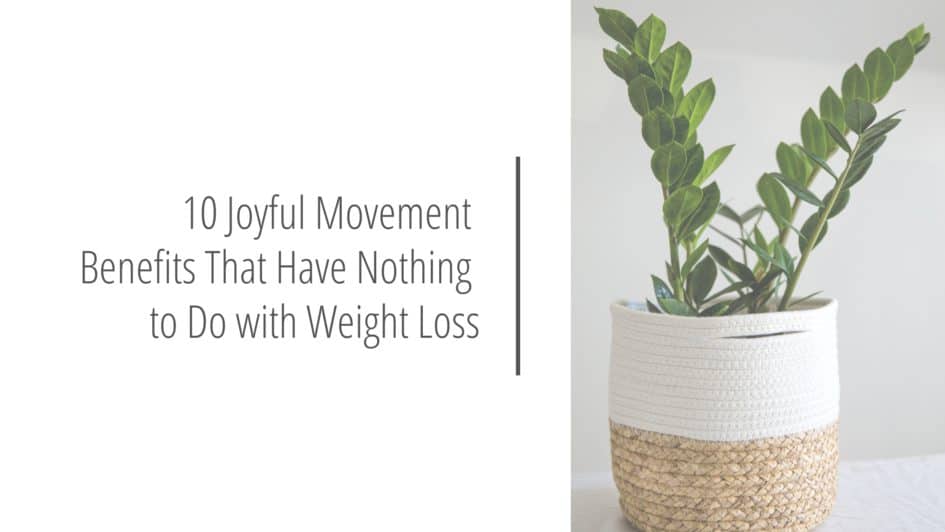Table of Contents
Making Joyful Movement the Focus
Exercise is often marketed as a tool for weight loss, but reasons to exercise go far beyond just burning calories. I’ve learned to focus on joyful movement, which includes activities that make me feel good in my body, rather than focusing on how many calories I burn or the number on the scale.
Joyful movement is all about finding physical activities that bring you joy, whether it’s dancing, walking, yoga, gardening, rollerblading, fitness classes at the gym, rock climbing, running, or hiking, you name it. It’s about moving because it feels good, not because you feel obligated.
When you shift your focus to the many benefits of exercise, aka joyful movement, it becomes easier to stay motivated and consistent. Here’s a breakdown of exercise benefits that have nothing to do with weight, and why joyful movement is an important part of overall health.
1. Improves Sleep Quality
Regulates circadian rhythm
Exercise plays a key role in regulating your body’s internal clock, also known as the circadian rhythm. This rhythm is responsible for your natural sleep-wake cycle, and when it’s in sync, it makes falling asleep and staying asleep easier.
Enhances deep sleep
Physical activity also increases the amount of time you spend in deep sleep, which is the most restorative phase. A 2018 study found that people who exercised reported better sleep quality, with more restful nights and better recovery from physical and mental exertion (Kredlow et al., 2018).
2. Reduces Stress Levels & Boosts Mood
Endorphin Boost
Exercise is one of the most effective ways to manage stress because it triggers the release of endorphins, which are chemicals that naturally boost your mood and reduce feelings of stress.
Cortisol Reduction
When you work out, your body reduces the production of cortisol, the hormone released in response to stress. Over time, regular physical activity can help lower chronic stress and its harmful effects on the body. Studies show that exercise can effectively lower cortisol levels and reduce symptoms of stress (Hamer et al., 2008).
Fighting Depression and Anxiety
Studies show that regular exercise can be as effective as antidepressants for managing symptoms of depression and anxiety. In fact, just 30 minutes of moderate exercise can improve mood and reduce the symptoms of mental health disorders (Rebar et al., 2015).
3. Increases Bone Density
Bone-Strengthening Exercises
As we age, our bones naturally lose density, but weight-bearing exercises, like walking, running, and resistance training, can help maintain and even increase bone density. These exercises stimulate bone-forming cells, helping prevent osteoporosis and fractures.
Long-Term Bone Health
Maintaining strong bones is essential for a good quality of life, especially as we get older. Research shows that regular physical activity promotes bone health well into your senior years, reducing the risk of bone fractures and osteoporosis later in life (Martyn-St James & Carroll, 2008).
4. Can Reduce the Risk of Heart Disease
Stronger Heart Muscle
Exercise strengthens the heart muscle, improving its efficiency at pumping blood and delivering oxygen throughout the body. A strong heart reduces the workload, lowering the risk of heart disease.
Improved Circulation
Regular physical activity also improves circulation, helping blood vessels become more flexible, which leads to better heart function. Studies show that people who engage in regular exercise have a significantly lower risk of heart disease and related conditions (Thyfault & Booth, 2011).
5. Reduces Blood Pressure
Improved Blood Vessel Function
Exercise improves blood vessel flexibility and function, which helps lower blood pressure over time. Physical activity, especially aerobic exercises like walking, swimming, and cycling, can help reduce both systolic and diastolic blood pressure.
Lower Risk of Hypertension
For those with high blood pressure, regular exercise is an effective way to bring it back to a healthy range. In fact, studies have shown that just 30 minutes of moderate exercise most days can lower blood pressure by 5-7 mmHg, reducing your risk of stroke and heart attack (Cornelissen & Fagard, 2005).
6. Improves Memory
Increased Blood Flow to the Brain
When you exercise, blood flow to the brain increases, delivering more oxygen and nutrients that are essential for cognitive function. This helps support memory, focus, and learning ability.
Neuroplasticity
Exercise also promotes neuroplasticity, which is the brain’s ability to form new connections and adapt. Studies have shown that people who exercise regularly tend to perform better on memory and cognitive tests, and they experience a slower decline in brain function as they age (Niemann et al., 2014).
7. Reduces Total Cholesterol: Protecting Your Arteries
Improves Cholesterol Profile
Exercise has a direct impact on cholesterol levels, particularly by increasing HDL (good cholesterol) and lowering LDL (bad cholesterol). High levels of LDL cholesterol contribute to plaque buildup in the arteries, which can increase the risk of heart disease.
Long-Term Heart Health
Regular physical activity helps keep cholesterol in check by improving the balance between HDL and LDL. Over time, this leads to healthier arteries, reducing the overall risk of cardiovascular issues (Rognmo et al., 2012).
8. Improves Insulin Sensitivity
Efficient Use of Glucose
Exercise helps your muscles use glucose more effectively, improving insulin sensitivity. This is crucial for controlling blood sugar levels and reducing the risk of type 2 diabetes.
Long-Term Blood Sugar Control
Over time, regular physical activity helps maintain healthy blood sugar levels by improving the body’s ability to respond to insulin. This is important for preventing insulin resistance, which can lead to diabetes and other metabolic disorders (Colberg et al., 2016).
9. Boosts Immune Function
Enhances Immune Response
Regular exercise can boost your immune system, making your body more effective at warding off infections and illnesses. Physical activity increases the circulation of immune cells, such as white blood cells, that help detect and fight harmful pathogens in your body.
Moderate Exercise, Better Protection
Studies have shown that moderate, consistent exercise improves immune function and can reduce the frequency of illness. It also speeds up recovery times when you do get sick. While intense or over-exercising can temporarily suppress the immune system, engaging in moderate exercise like walking, jogging, or yoga can enhance your body’s defense mechanisms, helping you stay healthier overall (Nieman, 2003).
10. Improves Satiety Cues
Regulating Appetite Hormones
Exercise helps regulate hormones that control hunger and satiety, such as ghrelin (which stimulates appetite) and leptin (which signals fullness). Regular physical activity can improve your body’s natural hunger cues, making it easier to eat mindfully and avoid overeating.
Better Appetite Control
Research has shown that people who exercise regularly are better able to recognize true hunger cues and make healthier food choices. Over time, this leads to more balanced eating habits and better control over food intake (Dohm et al., 2011).
Summary
Exercise isn’t just about burning calories or losing weight. It’s about improving your overall health and well-being. By focusing on the many benefits of physical activity, like better sleep, reduced stress, stronger bones, improved heart health, and enhanced mood, exercise becomes a sustainable and enjoyable part of your routine.
Whether it’s boosting your memory, improving insulin sensitivity, or helping you tune into your body’s hunger cues, the advantages of movement extend far beyond physical appearance.
Learn to embrace joyful movement, aka exercise activities that feel good to you, can keep you motivated and support your long-term health goals, ensuring you stay active for years to come.
Thanks for reading!
Rachel Beiler, MHS, RD, LDN
References
- Colberg, S. R., Sigal, R. J., Yardley, J. E., et al. (2016). Physical Activity/Exercise and Diabetes: A Position Statement of the American Diabetes Association. Diabetes Care, 39(11), 2065-2079.
- Cornelissen, V. A., & Fagard, R. H. (2005). Effects of endurance exercise on blood pressure, blood pressure-regulating mechanisms, and cardiovascular risk factors. Hypertension, 46(4), 667-675.
- Dohm, L. G., St. Laurent, R., & Park, K. (2011). Exercise and appetite regulation: Role of ghrelin and leptin. Journal of Physical Activity and Health, 8(6), 811-818.
- Hamer, M., & Steptoe, A. (2008). Physical activity and cortisol response to acute mental stress. Biological Psychology, 77(2), 174-179.
- Kredlow, M. A., Capron, L. W., & Otto, M. W. (2018). The effects of exercise on sleep: A meta-analytic review. Journal of Behavioral Medicine, 41(5), 591-601.
- Kramer, M. S., et al. (2002). Endurance exercise training and heart rate recovery in patients with coronary artery disease. Journal of Cardiopulmonary Rehabilitation, 22(6), 328-336.
- Martyn-St James, M., & Carroll, S. (2008). The effectiveness of exercise for improving bone mineral density in postmenopausal women: A meta-analysis of randomized controlled trials. Bone, 43(4), 890-899.
- Niemann, C., et al. (2014). Effects of physical exercise on memory and cognitive functions in healthy elderly individuals: A systematic review. Psychological Reports, 114(3), 534-552.
- Rognmo, Ø., et al. (2012). Cardiovascular risk of high-intensity exercise: A systematic review. European Journal of Preventive Cardiology, 19(6), 431-441.
- Rebar, A. L., et al. (2015). Physical activity and depression: A systematic review of meta-analyses. Health Psychology Review, 9(4), 391-410.
- Thyfault, J. P., & Booth, F. W. (2011). Lack of exercise is a major cause of chronic diseases. Comprehensive Physiology, 2(2), 1143-1211.
- Nieman, D. C. (2003). Exercise immunology: Practical applications. International Journal of Sports Medicine, 24(3), 180-185.


Leave a Reply